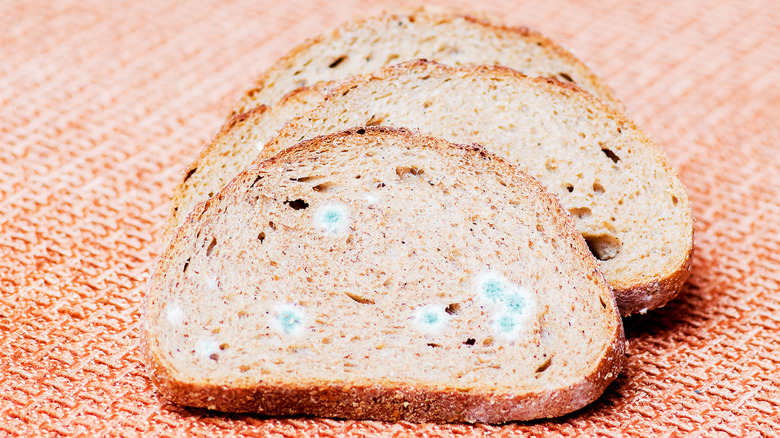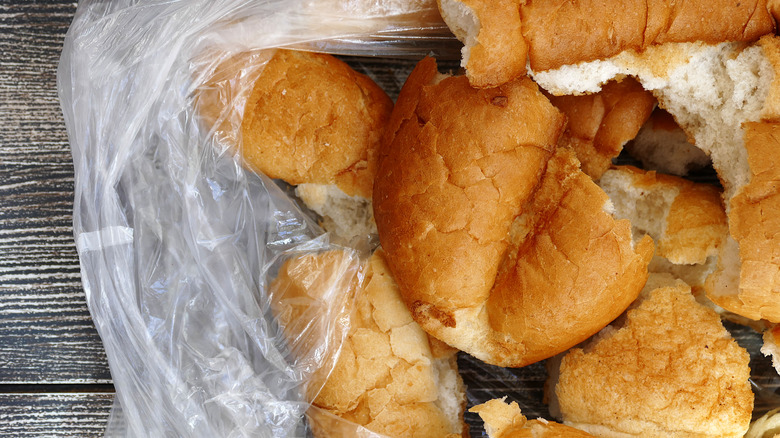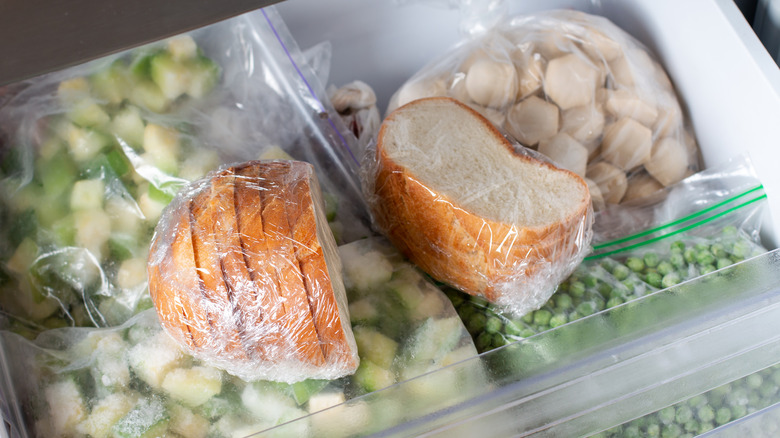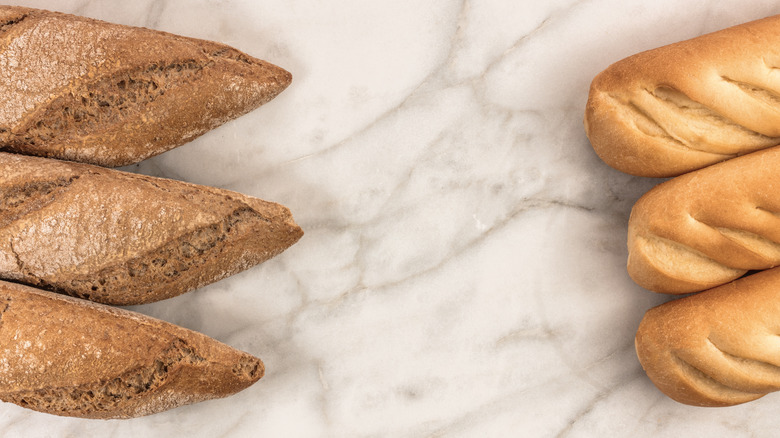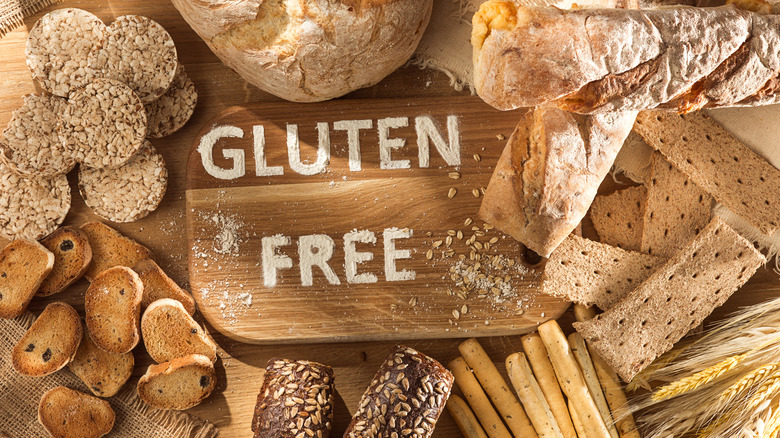Ditch Your Bread Expiration Date: How To Know If Your Loaf Has Actually Gone Bad
We may receive a commission on purchases made from links.
Bread has been a dietary staple of human civilization for thousands of years. While there is evidence of something akin to a barley cake dating back 22,000 years ago in what is modern-day Israel, the first yeast bread dates back to 1,000 B.C. in Egypt, per Live Science. Since then, bread has evolved to utilize a wide range of grain varieties, and its shelf life has been expanded through the incorporation of various preservatives. That being said, the debate as to how to know if your loaf of bread has gone bad is still very much alive. While expiration dates are commonly indicated on store-bought loaves, this is generally more of a suggestion than a definitive date by which the bread should be consumed.
As per the USDA, the general shelf life of commercially manufactured bread is 2 to 4 days at room temperature, 7 to 14 days in the refrigerator, or up to 3 months when frozen. However, a number of factors may come into play where the shelf life of bread is concerned. How the bread is packaged, the type of bread, and the unique microclimate within which you live all factor into how long your bread will last (via MasterClass). Based upon all of these factors, we wanted to delve into the tell-tale signs of when bread is past its safe-to-consume stage, ranging from the appearance of mold to the presence of a foul stench.
You see mold
According to Healthline, mold is a fungus related to, but not identical to, mushrooms. It develops as a colony of spores that emerge as foods age by metabolizing the nutrients within that food item. Bread in particular is susceptible to a number of different kinds of mold including Aspergillus, Penicillium, Fusarium, Mucor, and Rhizopus. Regardless of which kind of mold or variation of a particular mold species your bread is inhabited by, you should never consume moldy bread.
While mold may only appear to be growing on the surface of the bread, the roots of the mold spores can quickly invade an entire loaf. These spores contain poisonous mycotoxins that can make you ill. Furthermore, long-term exposure to these mycotoxins can cause irreparable damage to your gastrointestinal flora by interrupting the proliferation of good bacteria. The consumption of mold from the Aspergillus strain of mold has even been linked to the development of cancer.
The best way to inhibit mold growth in bread, particularly those without preservatives, is to keep it away from moisture. Placing it in an airtight container wrapped in a paper towel is a start. It is also recommended that you cool bread thoroughly before storing it if you are baking it from scratch. And bread should always be kept in a cool, dry place, away from sunlight — like a bread basket or kitchen cabinet.
The bread smells
Few things are as tantalizing as the smell of fresh bread coming out of the oven. You know that distinct yeasty smell that makes you want to rip right into it and slap some butter on it? That's the stuff of dreams. However, as bread ages, it begins to develop a distinctly off-putting smell redolent of vinegar or a fermented malt beverage (via BakingHow). Once this occurs, the bread has gone rancid and should be discarded. The one exception to this may be sourdough bread, which naturally has this type of scent and generally has a longer shelf life thanks to the fermentation of the yeast starter, per Well + Good.
There is yet another smell you should avoid where bread is concerned, and that is moldy bread (via Healthline). Inhaling mold spores can aggravate mold allergies, leading to not only difficulty breathing, but potentially to an anaphylactic response. Additionally, mold rhizomes can lead to a serious infection in those with weakened immune systems, such as the young, elderly, pregnant or breastfeeding women, and those with a chronic illness.
And finally, according to the Government of Canada, there is the possibility of bread becoming contaminated by "wild" yeast during the cooling, slicing, or packaging process. This will result in bread that has a chemical odor to it, similar to acetone. This condition in bread may lead to gastrointestinal discomfort, therefore the bread should be either discarded or returned to the location where you obtained it.
It tastes off
When we talk about using our five senses to eat, we usually say you should start with your eyes, then use your nose, and then move on to your mouth. Without any visible mold or noticeably rancid smell, your next best way of determining whether bread has gone bad is your taste buds. Fresh bread has an unmistakable flavor that is sweet, salty, and has a slight yeasty bite in the background. If you notice your bread developing a flavor that is acrid or vinegary, throw it away (via BakingHow).
However, if you have a fresh loaf of bread that tastes sour, it may not be rancid, there may be other factors at play. Sourness in bread can also be the result of using too much yeast, over-proofing, expired yeast, or under-baking. It is important to note the flavor as your bread ages. Particularly with fresh bread that doesn't have any preservatives, you will notice a change in flavor far more distinctly than with store-bought bread loaded with preservatives.
It's too hard to eat
Many foods suffer the fate of becoming stale as they age. Bread is no exception to this rule. Per WebMD, bread goes stale as a result of the loss of moisture. As the starches begin to break down in your loaf of bread, moisture will leach out causing it to become dry and hard as a rock. While this isn't particularly appealing, it isn't altogether dangerous to consume. Generally, if bread is heated, via either a microwave or toasted, it can be rejuvenated.
There are other options for dealing with stale bread, as plenty of cultures across the globe have discovered. From making croutons to Panzanella to grinding it into bread crumbs, stale bread can become a powerful tool to be incorporated into your culinary arsenal. Additionally, stale bread has been discovered to be a practical aid in various household projects (via Almanac). Some of our favorites include using it to clean your coffee grinder, cleaning greasy fingerprints off photos, removing crayon or pencil marks off your wall, and using it to soften brown sugar. Obviously, none of these apply if you are dealing with moldy bread, which can be a dangerous contaminant.
Why you should avoid eating bread that's gone bad
Aside from the fact that consuming bread that has gone bad is deeply dissatisfying, it can make you sick. The primary culprit of this has to do with mold, per Livestrong. Chances are that a bite or two won't likely make you ill, but this isn't always the case, as there is no way to know what type of mold is growing on and in your bread. Additionally, the onset of symptoms may differ depending upon the type of reaction you experience.
There are three common responses to consuming bad bread: an allergic reaction, respiratory distress, and food poisoning. Allergies to mold generally come with typical symptoms including sneezing, watery eyes, itchiness, and skin irritations. Respiratory distress typically manifests in wheezing, coughing, shortness of breath, and chest tightness, although those with asthma can develop severe reactions. Food poisoning is characterized by nausea, vomiting, abdominal cramping, diarrhea, fever, and dehydration. If these symptoms persist for more than three to four days, seek medical attention immediately. It is important to note that unlike hard cheeses, firm fruits and vegetables, and cheeses that involve the injection of various forms of mold in their production (like gorgonzola or blue cheese), mold cannot be safely cut away from bread (via Insider).
How to extend the shelf life of bread
A number of factors should be considered when deciding how to store bread for an extended shelf life. First, if you have a family that will easily polish off a loaf of bread in just a few days, keeping it at room temperature, wrapped in an airtight container, and in a cool dry place away from sunlight is ideal.
If you are alone and cannot consume a whole loaf of bread within a few days, it may be best to refrigerate it or freeze it in a Ziploc bag. Insider suggests that certain types of bread may last longer in the freezer than others. Breads with less fat that are denser typically will last for three months, while higher-fat breads (like a croissant or brioche) may last for up to six months. Additionally, while sliced bread can run the risk of freezer burn, it is certainly convenient to simply remove one slice of bread at a time from the freezer. Just make sure it is properly wrapped.
Lastly, King Arthur Baking Company suggests that bread should be sliced from the center out rather than from the edges when stored at room temperature. This will help the bread retain a tender texture. The company also notes that even though crusty breads will lose their crunch when wrapped in an airtight container at room temperature, doing so will keep them moist longer. The crunch of this type of bread can be restored with heat.
Is there a difference between the shelf life of whole wheat and white bread?
There is a dearth of research to suggest that consuming whole wheat bread has nutritional advantages to white bread (via Insider). Generally speaking, whole wheat bread is higher in fiber and is rich in vitamins and minerals thanks to the retention of the bran and germ in the endosperm of the bread. That being said, many commercially produced white breads are now manufactured using enriched flours that are fortified with iron and B vitamins. White bread may also be more suitable for those with chronic gastrointestinal issues like Crohn's disease, ulcerative colitis, and gastroparesis, which tend to be aggravated by the consumption of high-fiber foods.
However, there's more to the debate of whole wheat versus white bread, particularly where the shelf life of bread is concerned. As a general rule of thumb, denser whole wheat breads lack some of the moisture associated with white breads, making them less susceptible to mold (via Reference). Commercially produced white bread, however, is usually treated with a host of preservatives and antimycotics, which increase shelf life, prevent molding, and help the bread retain a tender texture. So the answer to this question is — it depends. Either way, if you are baking your own bread, it will likely go bad way before anything you purchase from the grocery store.
Is there a difference between the shelf life of gluten-free and regular bread?
If you have ever purchased gluten-free bread, you will notice that it most frequently is either stored in the freezer section of the grocery store or comes in vacuum-sealed packaging. This is because gluten-free bread has a notoriously short shelf life. If you thought regular bread didn't last long enough, gluten-free bread is even more fickle. Once you open the package, it will be moldy within just a couple of days.
Gluten Free Necessity explains some of the reasons why this occurs. First, gluten-free bread contains a higher percentage of refined starch. These starches are generally obtained from products like potatoes and corn and are used to replace some of the elasticity that is lost due to the elimination of wheat. These refined starches are particularly susceptible to heat. The second they begin to cool, they begin to lose moisture, causing them to go stale almost instantly.
Gluten-free breads are also typically made with the addition of more water so as to increase the moisture of the dough. This added moisture makes it fertile ground for mold to take hold. And where most commercially produced bread contains preservatives that deter mold production, these preservatives are often left out of gluten-free breads as they have been associated with the proliferation of symptoms associated with gluten intolerances. The bottom line: Keep your gluten-free bread in the freezer and only remove what you need as you need it to prolong its shelf life.
Best ways to use up old bread before it goes bad
There are so many amazing recipes for using up slightly stale bread. In fact, stale bread is an integral component in many recipes. Crostini and bruschetta are both best with bread that is just slightly stale and then toasted, otherwise it tends to disintegrate underneath a moist topping. A classic gazpacho utilizes bread as a thickener when toasted and combined with the bounty of summer, including cucumbers, tomatoes, and peppers. And a classic French Onion Soup à la Julia Child is nothing without a slice of toasted bread topped with copious quantities of melted gruyere that you slowly dunk into the luscious rich broth to soak it up.
But let's not forget breakfast. Slightly stale bread is the key to making a perfect french toast and strata, which for lack of a better way of describing it is like a savory vegetable french toast. We like making a baked french toast and strata that sits in the refrigerator overnight while the egg custard slowly absorbs into the bread. The resulting dish develops a golden brown top, and a moist, luxurious center. And when you are making a classic French Croque Madame, the perfect crunchy bread is a must. We suggest using slightly stale bread that will crisp up brilliantly and won't get soggy under your luscious bechamel sauce.
Why you shouldn't feed stale bread to animals
Many of us grew up feeding stale bread to ducks and geese at the park. They seemed happy enough to eat the bread and we giggled as we watched them flock around us. But, as experts at the Glade Run Lake Conservancy note, feeding bread to wildlife is extremely dangerous. Not only are they susceptible to the same mycotoxins as we are, which can kill an animal that consumes moldy bread, but bread has no nutritional value for animals. The sugars, salt, and carbohydrates present in bread are actually deadly to many species, including fish, squirrels, and birds who cannot digest them properly.
Additionally, feeding animals can disrupt delicate ecosystems by contaminating water, making animals dependent upon us for food, and disrupting the natural populations of some species in certain areas. When this occurs, a habitat can easily become stressed and it throws the balance of the entire wildlife population out of whack. With animal populations already experiencing stressors related to humans encroaching on their natural habitats and climate change, we shouldn't be adding another factor into this toxic mix.

